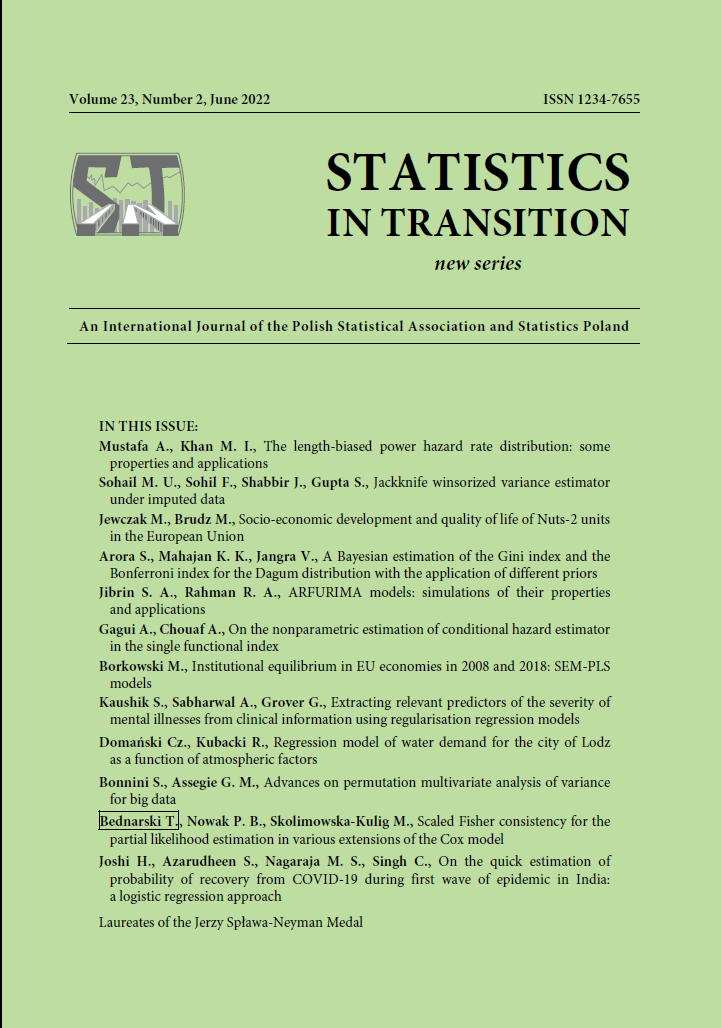ARTICLE
ABSTRACT
Analyses regarding socio-economic development and quality of life are an important aspect of research and discussion for many international organisations, states and local authorities. Due to the complexity and multidimensionality of these issues, conducting research can be problematic. The conclusions of various analytical centres indicate that there are many paths towards establishing a set of factors which affect quality of life and ways of assessing socio-economic development levels. Depending on the criteria considered, the most common methods for determining the degree of the advancement of life quality or socio-economic development include taxonomical techniques and analyses of potential, which are based mainly on objective data sourced from official registers. The main purpose of the paper is to investigate the level of socio-economic development and quality of life in the European Union in the years 2004 and 2018. The analyses were conducted for a rarely used level of spatial data aggregation, i.e. for NUTS-2 units. The analysis covers only those European regions that were EU members in 2004. As the primary research tool, the two-dimensional development matrix was adopted, which enabled the verification of the hypothesis regarding the convergence of synthetic measures that indicate the levels of socio-economic development and quality of life in the EU regions. For these indices, the development matrix is also used to identify the strengths and weaknesses as well as the opportunities and threats for selected spatial units, and, at the same time, to estimate the rates of change of the socio-economic development and quality of life levels.
KEYWORDS
quality of life, development matrix, taxonomic techniques, regional analyses
REFERENCES
Agénor, P. R., Lim, K. Y., (2018). Unemployment, growth and welfare effects of labor market reforms. Journal of Macroeconomics, 58, pp. 19–38.
Annoni, P., De Dominicis, L. and Khabirpour, N., (2019). Location matters: A spatial econometric analysis of regional resilience in the European Union. Growth and Change, 50(3), pp. 824–855.
Begg, D., Fischer, S. and Dornbusch, R., (2007). Makroekonomia, PWE, Warszawa.
Brudz, M., Jewczak M., (2019). Quality of life and labour market in Poland, In M. Papież and S. Śmiech (Eds.), The 13th Professor Aleksander Zelias International
Conference on Modelling and Forecasting of Socio-Economic Phenomena, Conference Proceedings, Wydawnictwo C.H. Beck, Warszawa, pp. 17–25.
Cyrson, E. (ed.), (1997). Kompendium wiedzy o gospodarce, PWN, Warszawa–Poznań.
Đurović, G., Bigović, M. and Milović, N., (2017). Support for further enlargement of the EU: Statistical analysis of regional differences. Journal of Balkan and Near Eastern Studies, 19(3), pp. 243–258.
Ertur, C., Le Gallo, J. and Baumont, C., (2006). The European regional convergence process, 1980-1995: Do spatial regimes and spatial dependence matter?. International Regional Science Review, 29(1), pp. 3–34.
European Commission, (2019). Constructing a composite indicator, https://ec.europa.eu/jrc/en/coin/10-step-guide/overview (accessed on: 10.01.2019).
Fitouss, J. P., Sen, A. K. and Stiglitz, J. E., (2011). Mismeasuring Our Lives: Why GDP Doesn't Add Up. ReadHowYouWant.com.
Hawthorne, G., Osborne, R., (2005). Population norms and meaningful differences for the Assessment of Quality of Life (AQoL) measure. Australian and New Zealand journal of public health, 29(2), pp. 136–142.
Hellwig, Z., (1968). Zastosowanie metody taksonomicznej do typologicznego podziału krajów ze względu na poziom ich rozwoju oraz zasoby i strukturę wykwalifikowanych kadr. Przegląd statystyczny, 4(1968), pp. 307–326.
Hydzik P., (2012). Zastosowanie metod taksonomicznych do oceny poziomu rozwoju społeczno-ekonomicznego powiatów województwa podkarpackiego. Zeszyty Naukowe Politechniki Rzeszowskiej, Ekonomia i Nauki Humanistyczne, z. 19 (2/2012), pp. 17–32.
Jewczak, M., Korczak, K., (2020). Poverty and Health State in Poland: Evidence from a regional perspective. Management Issues, 18, 3(89), Warsaw, pp. 49–66.
Nermend K., (2017). Metody analizy wielokryterialnej i wielowymiarowej wspomaganiu decyzji, PWN, Warszawa.
OECD, JRC European Commission, (2008). Handbook on constructing composite indicators: methodology and user guide, OECD Publishing.
PWN, (2021). Rozwój, https://encyklopedia.pwn.pl/haslo/rozwoj;4009883.html (accessed on: 10.02.2021).
Robine, J. M., Romieu, I. and Cambois, E., (1999). Health expectancy indicators. Bulletin of the World Health Organisation, 77(2), p. 181.
Samuelson, P. A., Nordhaus, W. D., (2012). Ekonomia. Rebis, Warszawa.
Schumpeter, J.A., (1960). Teoria rozwoju gospodarczego, PWN, Warszawa.
Stanickova, M., (2015). Classifying the EU competitiveness factors using multivariate statistical methods. Procedia Economics and Finance, 23, pp. 313–320.
Stiglitz, J., Sen, A. and Fitoussi, J., (2018). Beyond GDP. Project Syndicate.
Suchecki, B. (ed.), (2010). Ekonometria przestrzenna: metody i modele analizy danych przestrzennych, Wydawnictwo CH Beck.
Tomkiewicz, J., (2018). The labour market and income distribution in postsocialist economies – Non-obvious regularities. Communist and Post-Communist Studies, 51(4), pp. 315–324.
UNDP, (2020). Human Development Report 2020. The next frontier. Human development and the Anthropocene. The United Nations Development Programme Publishing.
WHO, (1997). Division of Mental Health and Prevention of Substance Abuse.
WHOQOL: measuring quality of life. World Health Organization, https://apps.who.int/iris/handle/10665/63482 (accessed on: 10.09.2020).
